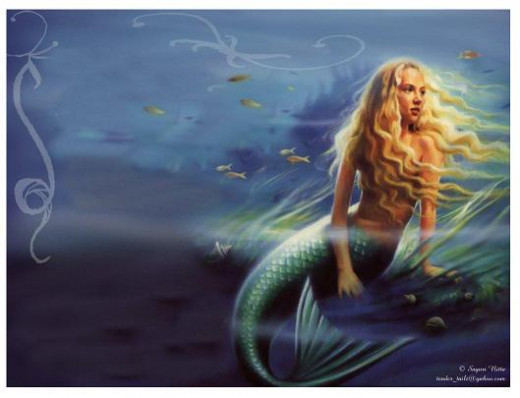Mermaids, Mermen, and Merfolk - Myth or Real Magic?

By Joan Whetzel
Once upon a time, there was a mermaid, who embarked on a journey to the surface of the ocean to explore the lands above sea and the people who lived there. Fairy tales like this have been told for centuries. These legendary creatures of the sea, the merfolk, have become a part of our mythology. In the light of NOAAs recent statements that mermaid do not exist, and in light of the fact that so many societies produced mermaid tales independently of one another, it makes one wonder how much of the mermaid folklore is real, how much is fictitious, and where the mermaid stories originated.
What Are Mermaids?
Mermaids are commonly described as an aquatic creature with a human torso and a pelvis and tail resembling that of a fish. Mermaids are, of course, the female variation of the species. The males of the species are referred to as a merman, and the species as a whole are called merfolk or merpeople. The term "mermaid" comes from the Old English word mere, meaning "the sea," and the word maid, meaning "girl" or "young woman."
The half-human, half-fish sea sirens known as mermaids have become legendary through multiple retellings of a wide ranges of stories from different countries. They are called sirens because they are seen as femme fatales, dangerous women who enchant and mesmerize sailors with their music, causing them to shipwreck and luring the sailors to their deaths.
Mermaid Appearance
Mermaids, and merfolk in general, are seen as human and fish hybrids. However, the various mermaid traditions have offered a few additional clues about their appearance. They are beautiful in appearance in almost all of the tales. Their beauty, in fact, is part of their allure. The female, the mermaids, generally have long flowing hair, which tends to be seen as an attractive feature to human men. In some traditions, the mermaid's fish scales take on a shimmering, iridescence. Some traditions give the mermaids a somewhat more eerie or frightening physical characteristic in the form of fang-like teeth. Mermaids are also said to have webbing between their fingers.
In the "Pirates of the Caribbean" movie series, the mermaids had a pearlescent skin tone and hair similar in color to the sea where they lived. When seen with the peripheral vision, their beauty disappeared, changing their appearance into hideous creatures that had tentacles with claws, fanged teeth, and skin covered with barnacles and boils.
Mermaids are said to possess a superhuman strength which enables them to rupture the solid wood hulls of ships, snatch their prey (the sailors), and carry them to the depths of the sea, all with their bare hands. In some traditions, the mermaids use seaweed lassos to capture their prey off the land or even off of cliffs, before dragging them off to the depths of the sea. In many versions of the mermaid tales, once they've got their prey where they want them, the mermaids are said to feed on the sailors. Mermaids are also said to have the ability to swim at great speeds.
Mermaids are able to leave the water and turn human. As long as they remain out of the water for at least 10 seconds, they will maintain their human form. However, if they get touched by water within that first 10 seconds after taking on human form, they will return to their mermaid form. Even if they have been in human form for any length of time, once in contact with water, they return to mermaid form when in contact with water for at least 10 seconds. Clothing appears when they take on their human form, but disappears when metamorphosing back into mermaid form.
Mermaid Stories
One of the more famous mermaid tales, "The Little Mermaid" was penned by Hans Christian Andersen. It tells the tale of a young mermaid that falls in love with a human prince and is given the gift of a human form to go after him. But she has to get him to fall within a certain length of time. "The Little Mermaid" was first immortalized in bronze in the form of a famous sculpture placed along the harbor in Copenhagen and again in the Disney film by the same name.
Mermaids made their appearance in another Disney film, one of the "Pirates of the Caribbean" films. In addition, Animal Planet put on a documentary about mermaids called "Mermaids: The Body Found" in May of 2012; only weeks before the NOAA announcement that there was no evidence of mermaids, coincidentally.
Mermaids have become good luck charms for many stories about the sea and about pirates. They have also been equated with manatees, a.k.a. sea cows.
In Greek mythology, sirens are often depicted as mermaid-like creatures. In other similar stories, the mythical creatures are water fairies, or water nymphs, a species of animal that can change from a seal to a human. The sirens in Homer's "The Odyssey" were believed to have been mermaids.
Real Life Mermaids
A few modern day mermaid tales have emerged.
- Dead and/or living mermaids were spotted in several places including Java and British Columbia.
- Two reports were made in Vancouver and Victoria, Canada, one in 1967 and the other in the 19th century.
- The pirate, Blackbeard, was so afraid of running into merfolk that his crew sailed with strict instructions to steer clear of "enchanted waters", areas of the sea believed to infested with mermaids.
- The town of Kirvat Yam, Israel, in 2009, offered a prize of $1 million to anyone proving the existence of mermaids off the coast of Israel. The prize has yet to be presented to a winner.
- Claims that mermaids had chased workers away from 2 reservoir construction sites in Zimbabwe occurred in 2012.
NOAA has made the pronouncement that there are no mermaids, and that no evidences exists to prove that they ever lived. But it's doubtful that their "official" proclamation will put an end to the stories of mermaids, or the belief in their existence. Whether they are real or not probably won't really matter in the long run either. Mermaids are one of those myths that's just plain, old fun to believe in and no official declaration is going to put the myths and stories to rest.
Resources
Wikipedia. Mermaid.
http://en.wikipedia.org/wiki/Mermaid
NOAA. No Evidence of Aquatic Humans Has Ever Been Found.
http://oceanservice.noaa.gov/facts/mermaids.html
Pirates of the Caribbean Wiki. Mermaids.
http://pirates.wikia.com/wiki/Mermaid
h2o Wiki. Mermaids.
http://h2o.wikia.com/wiki/Mermaids
American Museum of Natural History. Water Creatures of the Deep: Becoming Mermaids.
http://www.amnh.org/exhibitions/mythiccreatures/water/mermaids.php
Discovery Channel. Mermaids: The Body Found.
http://press.discovery.com/ekits/monster-week-mermaids/press-release.html









